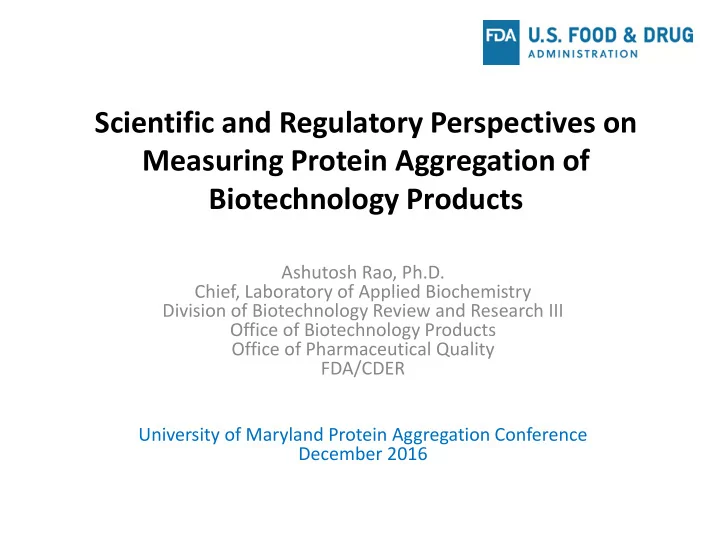

Scientific and Regulatory Perspectives on Measuring Protein Aggregation of Biotechnology Products Ashutosh Rao, Ph.D. Chief, Laboratory of Applied Biochemistry Division of Biotechnology Review and Research III Office of Biotechnology Products Office of Pharmaceutical Quality FDA/CDER University of Maryland Protein Aggregation Conference December 2016
Disclaimer The views expressed in this talk are those of the speaker and do not necessarily reflect the official position or policy of the U.S. Food and Drug Administration or the Department of Health and Human Services
Definitions and types • Protein aggregates are defined as any self-associated protein species, with monomer defined as the smallest naturally occurring and/or functional subunit. ( FDA Guidance for Industry: Immunogenicity Assessment for Therapeutic Protein Products ) • Aggregates are further classified based on five characteristics: size, reversibility/dissociation, conformation, chemical modification, and morphology ( Narhi et al. 2012 ) • Aggregates ranging from dimer to visible particles that are hundreds of micrometers in size ( Narhi et al. 2012 ) have been recognized for their potential to elicit immune responses to therapeutic protein products for over a half-century ( Gamble 1966 ) 3
ICH Q6B: Specifications 4
Protein aggregation and product- specific risk factors • Product origin (foreign or human) • Primary molecular structure and post-translational modifications • Higher-order structure of the aggregate • Pegylation/glycosylation • Aggregation by impurities with adjuvant activity • Immunomodulatory properties of the product • Formulation components • Container closure considerations • In-use conditions and product custody 5
Why control for aggregates? • Protein aggregates have the potential to negatively impact clinical performance • Current USP particulate testing is not designed to control the potential risk of large protein aggregates to impact immunogenicity • Development of quantitative analytical methods for particle counting and characterization is important for risk assessment and control of final drug product quality, safety, and efficacy 6
Methods for aggregate measurement 7
8
SE-HPLC 9
Examples of protein aggregation data FTIR Talikepalli et al 10
11
Regulatory expectations for soluble aggregates below 0.2 microns • Assay validation – ICH Q2R1: Validation of analytical procedures • Demonstrate good recovery from columns • System suitability criteria should be established to ensure recovery during routine assay performance • Lack of standards presents challenges for quantification – Assessment using different stressors • Is the method stability indicating? • Degradation pathway? • In-use stability? • Kinetics of degradation? – Suitable for cGMP environment – No single preferred method. SE-HPLC is most commonly used. 12
Regulatory expectations for soluble aggregates below 0.2 microns • Assay validation – Forced degradation: Oxidation (may need different methods to oxidize protein), deamidation, low/high pH, heat, photostability, light – Accelerated condition: temperature/humidity higher than recommended storage condition – Freeze/thaw – Shipping validation/agitation 13
Regulatory expectations for soluble aggregates between 10-25 microns • Monitoring particles between 10-25 micron is a regulatory requirement and compendial tests are available • Sponsors can chose which method they prefer to use • Compendial methods are considered validated but must be qualified for each lab • USP <788> testing should be added if they are not a current release specification 14
Regulatory expectations for soluble aggregates between 2-10 microns • Data for sub-visible particles between 2-10 microns is currently being requested using a qantitative method – Incorporated during early phases or as a PMC for licensed products • No preferred method or pre-established limit by FDA • Particles can be characterized for shape, type, size distribution 15
Setting specifications for quantitative methods • Risk to the product quality attribute(s) that drive safety and efficacy • Requires product knowledge • Clinical experience • Manufacturing history used to establish limits • Use of multiple DS/DP lots in clinical trials 16
Take home messages • Aggregates, SVP, and visible particles can pose a risk to patient safety and product efficacy • Specifications should be established for SVP below 0.2 micron and above 10 and 25 micron for parenteral and inhaled products • SVP between 2 and 10 micron should be evaluated using quantitative methods and an appropriate control strategy developed • SVP between 0.2 and 2 micron should be characterized and an appropriate control strategy developed 17
Acknowledgements • Susan Kirshner, Ph.D. • Rukman DeSilva, Ph.D. • Amy Rosenberg, M.D. • Colleagues in OBP, OPQ, academia and industry 18
Recommend
More recommend